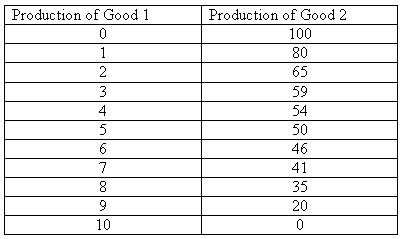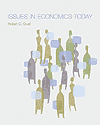 |
1 |  | 
 <a onClick="window.open('/olcweb/cgi/pluginpop.cgi?it=gif:: ::/sites/dl/free/0072345772/33367/guell_mcquiz_1_1.gif','popWin', 'width=NaN,height=NaN,resizable,scrollbars');" href="#"><img valign="absmiddle" height="16" width="16" border="0" src="/olcweb/styles/shared/linkicons/image.gif"> (2.0K)</a>
Suppose the table above represents points on a Production Possibilities Frontier, the point where the production of Good 1 is 5 and the production of Good 2 is 20 is <a onClick="window.open('/olcweb/cgi/pluginpop.cgi?it=gif:: ::/sites/dl/free/0072345772/33367/guell_mcquiz_1_1.gif','popWin', 'width=NaN,height=NaN,resizable,scrollbars');" href="#"><img valign="absmiddle" height="16" width="16" border="0" src="/olcweb/styles/shared/linkicons/image.gif"> (2.0K)</a>
Suppose the table above represents points on a Production Possibilities Frontier, the point where the production of Good 1 is 5 and the production of Good 2 is 20 is |
|  | A) | attainable. |
|  | B) | unattainable. |
|  | C) | one where there is unemployment. |
|  | D) | indicative of increasing opportunity cost. |
 |
 |
2 |  | 
Suppose the table above represents points on a Production Possibilities Frontier, the point where the production of Good 1 is 5 and the production of Good 2 is 10 is |
|  | A) | attainable. |
|  | B) | unattainable. |
|  | C) | one where there is unemployment. |
|  | D) | indicative of increasing opportunity cost. |
 |
 |
3 |  | 
Suppose the table above represents points on a Production Possibilities Frontier, the point where the production of Good 1 is 5 and the production of Good 2 is 5 is |
|  | A) | attainable. |
|  | B) | unattainable. |
|  | C) | one where there is unemployment. |
|  | D) | both a and c |
 |
 |
4 |  | 
Suppose the table above represents points on a Production Possibilities Frontier, the opportunity cost of going from 2 units of Good 1 to 3 units of Good 1 is |
|  | A) | 2 units of good 2 |
|  | B) | 4 units of good 2 |
|  | C) | 1 unit of good 1 |
|  | D) | 2 units of good 1 |
 |
 |
5 |  | 
Suppose the table above represents points on a Production Possibilities Frontier. Which of the following is true? |
|  | A) | The opportunity cost is increasing. |
|  | B) | The opportunity cost is constant. |
|  | C) | There is no scarcity. |
|  | D) | There are no tradeoffs. |
 |
 |
6 |  | 
 <a onClick="window.open('/olcweb/cgi/pluginpop.cgi?it=gif:: ::/sites/dl/free/0072345772/33367/guell_mcquiz_1_2.gif','popWin', 'width=NaN,height=NaN,resizable,scrollbars');" href="#"><img valign="absmiddle" height="16" width="16" border="0" src="/olcweb/styles/shared/linkicons/image.gif"> (2.0K)</a> Suppose the table above represents points on a Production Possibilities Frontier, the point where the production of Good 1 is 5 and the production of Good 2 is 100 is <a onClick="window.open('/olcweb/cgi/pluginpop.cgi?it=gif:: ::/sites/dl/free/0072345772/33367/guell_mcquiz_1_2.gif','popWin', 'width=NaN,height=NaN,resizable,scrollbars');" href="#"><img valign="absmiddle" height="16" width="16" border="0" src="/olcweb/styles/shared/linkicons/image.gif"> (2.0K)</a> Suppose the table above represents points on a Production Possibilities Frontier, the point where the production of Good 1 is 5 and the production of Good 2 is 100 is |
|  | A) | attainable. |
|  | B) | unattainable. |
|  | C) | one where there is unemployment. |
|  | D) | indicative of increasing opportunity cost. |
 |
 |
7 |  | 
Suppose the table above represents points on a Production Possibilities Frontier, the point where the production of Good 1 is 5 and the production of Good 2 is 50 is |
|  | A) | attainable. |
|  | B) | unattainable. |
|  | C) | one where there is unemployment. |
|  | D) | indicative of increasing opportunity cost. |
 |
 |
8 |  | 
Suppose the table above represents points on a Production Possibilities Frontier, the point where the production of Good 1 is 5 and the production of Good 2 is 20 is |
|  | A) | attainable. |
|  | B) | unattainable. |
|  | C) | one where there is unemployment. |
|  | D) | both a and c |
 |
 |
9 |  | 
Suppose the table above represents points on a Production Possibilities Frontier, the opportunity cost of going from 2 units of Good 1 to 3 units of Good 1 is |
|  | A) | 2 units of good 2 |
|  | B) | 6 units of good 2 |
|  | C) | 1 unit of good 1 |
|  | D) | 2 units of good 1 |
 |
 |
10 |  | 
Suppose the table above represents points on a Production Possibilities Frontier. Which of the following is true? |
|  | A) | The opportunity cost is increasing. |
|  | B) | The opportunity cost is constant. |
|  | C) | There is no scarcity. |
|  | D) | There are no tradeoffs. |
 |
 |
11 |  | 
To build a model of the economy which of the following tend to be useful |
|  | A) | fallacies of composition |
|  | B) | assertions that correlation and causation are the same |
|  | C) | simplifying assumptions |
|  | D) | trivializing generality |
 |
 |
12 |  | 
You know that if you get a 4.0 GPA at graduation that is better for you than if you get a 2.5 GPA. Because of the __________ you know that it is not necessarily in everyone’s combined interest for everyone to get a 4.0 (if this made a college degree worthless to employers.) |
|  | A) | fallacy of composition |
|  | B) | fallacy that correlation and causation are the same |
|  | C) | fallacy of the hypothetical |
|  | D) | fallacy of the round |
 |
 |
13 |  | 
When the production possibilities frontier models societal production but with only two goods, this is an example of |
|  | A) | simplifying assumption. |
|  | B) | the fallacy of composition. |
|  | C) | the fallacy that correlation and causation are the same. |
|  | D) | the fallacy of the round. |
 |
 |
14 |  | 
When people are influenced by a tax or regulation to do something they might not otherwise do then economists call this |
|  | A) | an incentive. |
|  | B) | an arbitrary observation. |
|  | C) | an unintended consequence. |
|  | D) | a lost opportunity. |
 |
 |
15 |  | 
The fact that production cannot exceed what is possible given available resources indicates that there is |
|  | A) | scarcity. |
|  | B) | the fallacy of composition at play. |
|  | C) | the fallacy that correlation and causation are the same at play. |
|  | D) | the fallacy of the round at play. |
 |




 2003 McGraw-Hill Higher Education
2003 McGraw-Hill Higher Education